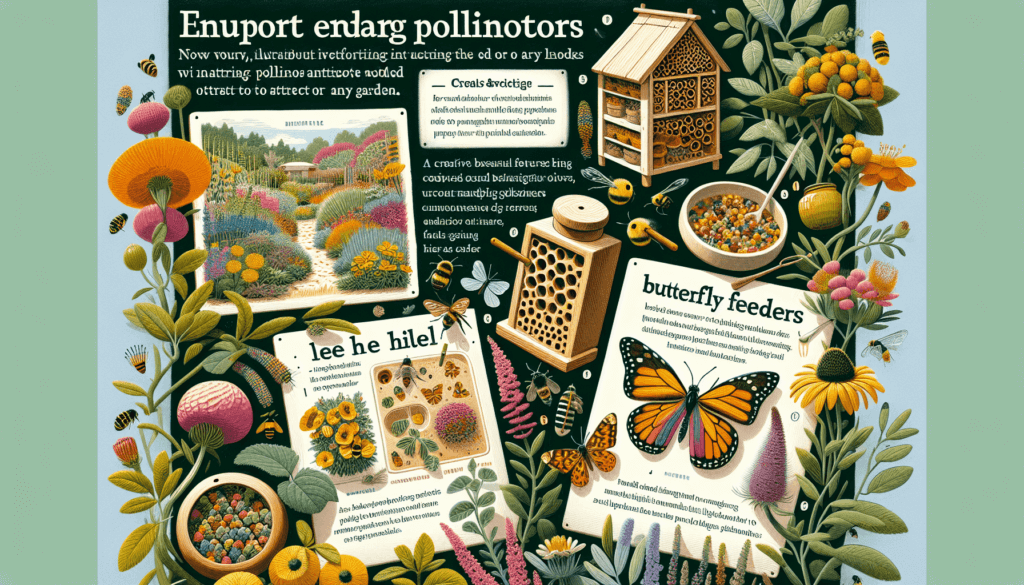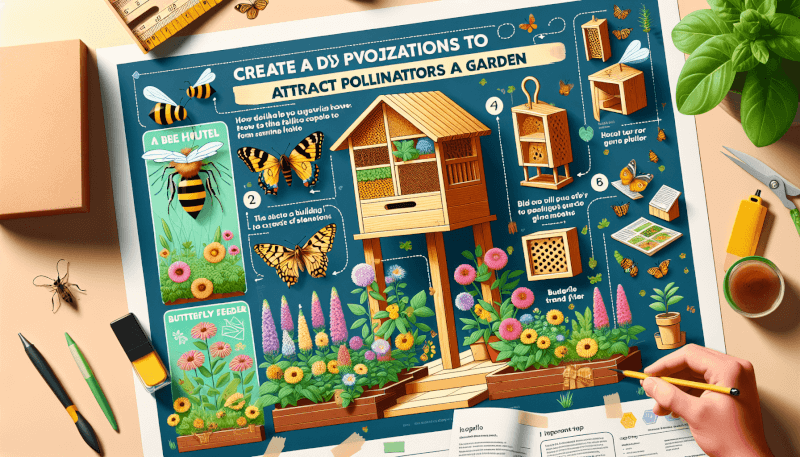If you’re an avid gardener looking to enhance the beauty of your outdoor oasis while also supporting the delicate ecosystem of pollinators, then these DIY projects are a must-try! By incorporating simple yet effective techniques, you can easily transform your garden into a vibrant sanctuary that attracts bees, butterflies, and other essential pollinators. From building enticing bee hotels to crafting colorful butterfly feeders, this article will guide you through the best ways to attract these crucial visitors to your garden, ensuring a flourishing environment for both plants and pollinators alike.
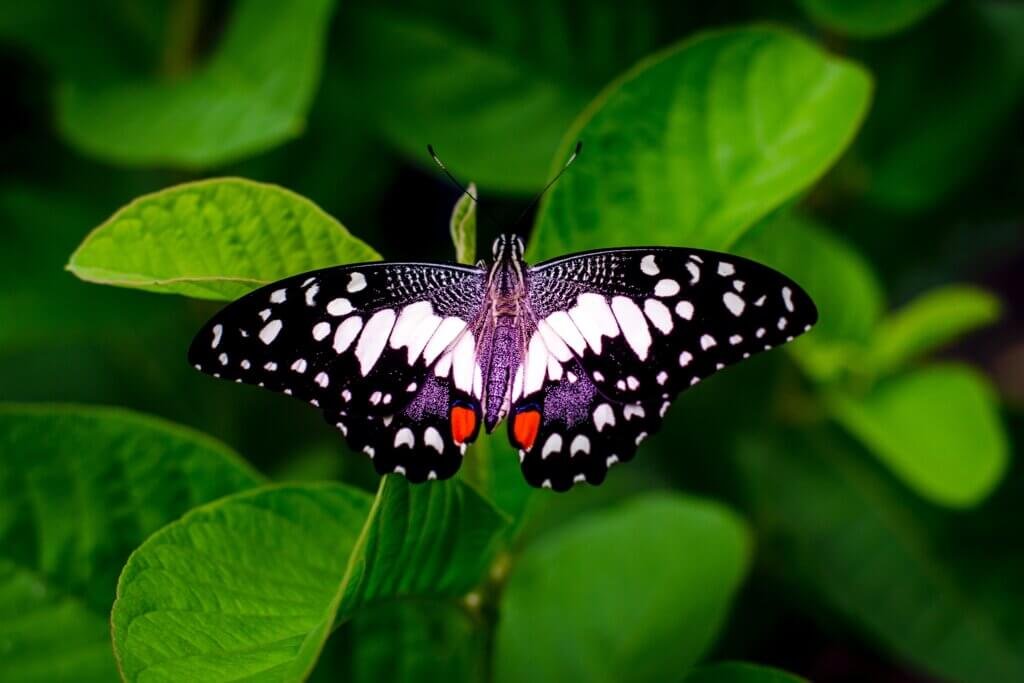
1. Selecting Pollinator-Friendly Plants
When it comes to attracting pollinators to your garden, one of the first and most important steps is selecting the right plants. By choosing the right flowering plants, you can create an inviting habitat for bees, butterflies, hummingbirds, and other important pollinators. Here are some tips to help you choose the best pollinator-friendly plants for your garden:
1.1 Choose Native Flowering Plants
Native flowering plants are well adapted to the local climate and soil conditions, making them an excellent choice for attracting pollinators. Native plants provide a familiar food source for local butterflies, bees, and other pollinators. When selecting native plants, consider their bloom time, size, and preferred growing conditions to ensure they will thrive in your garden.
1.2 Consider the Seasonal Blooms
To provide a continuous food source for pollinators throughout the year, it’s important to choose plants that bloom at different times. By selecting a variety of plants with staggered bloom times, you can ensure there is always something in bloom to attract pollinators. Consider including early spring bloomers like crocuses and daffodils, as well as late-season bloomers like asters and goldenrod.
1.3 Opt for Plants with Different Colors and Shapes
Pollinators are attracted to a wide range of flower colors and shapes. By including plants with different-colored flowers, you can attract a variety of pollinators to your garden. Bees, for example, are particularly attracted to blue, purple, and yellow flowers, while hummingbirds are drawn to bright red, orange, and pink blooms. Additionally, choose plants with different flower shapes, such as tubular flowers for hummingbirds and flat, open flowers for butterflies.
1.4 Plant a Variety of Flowering Plants
To create a diverse and attractive habitat for pollinators, it’s important to plant a variety of flowering plants. Different pollinators have different preferences when it comes to flower shape, size, and scent. By including a mix of flowers with varying characteristics, you can attract a wider range of pollinators to your garden. Consider planting a mix of annuals, perennials, and shrubs to provide a continuous source of nectar and pollen throughout the year.
2. Creating a Pollinator-Friendly Habitat
In addition to selecting pollinator-friendly plants, creating a welcoming habitat for pollinators is crucial. By providing the right conditions, you can encourage pollinators to visit, stay, and thrive in your garden. Here are some tips for creating a pollinator-friendly habitat:
2.1 Provide Shelter for Pollinators
Pollinators need a place to rest and take shelter from the weather and predators. Create habitat features like piles of rocks or logs, dense shrubs, or even a designated pollinator house. These features provide safe spaces for pollinators to rest and can also serve as nesting sites for certain species.
2.2 Include Water Sources
Just like any other living creature, pollinators need water to survive. Including a water source in your garden can help attract a wide range of pollinators. Create a shallow dish or birdbath with rocks or twigs for them to perch on while drinking. Be sure to refill the water regularly to provide a continuous water supply for the pollinators.
2.3 Add Nesting Material for Native Bees
Native bees, such as mason bees and leafcutter bees, are important pollinators that often nest in pre-existing holes or crevices. To attract these bees, provide suitable nesting materials such as bundles of hollow stems or drilled blocks of wood. By offering these nesting options, you can provide a safe and welcoming habitat for native bees.
2.4 Avoid Chemical Pesticides and Herbicides
Chemical pesticides and herbicides can be harmful to pollinators. Avoid using these products in your garden to create a safe and healthy environment for pollinators. Instead, opt for organic pest control methods or natural alternatives like companion planting or biological controls. By avoiding chemicals, you can help protect the pollinators that visit your garden.
3. Building DIY Pollinator Houses
Building DIY pollinator houses can provide additional shelter and nesting opportunities for pollinators. Here are some ideas for creating different types of pollinator houses:
3.1 Mason Bee House
Mason bees are excellent pollinators and are known for their ability to pollinate fruit trees and other crops. Building a mason bee house is a great way to attract and support these valuable pollinators. You can create a simple bee house using a piece of untreated wood with pre-drilled holes of the appropriate size for mason bees to lay their eggs and nest.
3.2 Butterfly House
Butterflies not only add beauty to your garden but also play a crucial role in pollination. Building a butterfly house can provide shelter for butterflies during harsh weather conditions and serve as a safe spot for them to rest and lay eggs. A butterfly house usually consists of a wooden structure with vertical slits or small openings that butterflies can enter.
3.3 Ladybug House
Ladybugs are natural predators of aphids and other garden pests, making them beneficial for organic gardening. Building a ladybug house can attract these helpful insects to your garden. A ladybug house is typically made of wood with small openings or slots for ladybugs to crawl into and seek shelter.
3.4 Hummingbird Feeder
Hummingbirds are important pollinators that are attracted to nectar-rich flowers. Building a hummingbird feeder is a simple DIY project that can bring these fascinating birds to your garden. Use a clean and sturdy container, fill it with a homemade or store-bought nectar solution, and hang it in a visible location to attract hummingbirds.
4. Installing Bee-Friendly Features
In addition to providing shelter and nesting options, you can further attract and support bees by installing specific bee-friendly features in your garden. Here are some ideas to consider:
4.1 Building a Bee Bath
Bees need access to water for hydration, especially during hot and dry periods. Building a bee bath is a great way to provide a water source for bees. Fill a shallow container with clean water and place stones or pebbles inside for the bees to land on while they drink. Make sure to keep the water fresh and refill it regularly.
4.2 Creating a Bee Watering Station
A bee watering station is another option to provide a water source for bees. Fill a shallow container with clean water and place a few floating objects like corks or pieces of wood on the surface. This gives the bees a safe place to land and access the water without the risk of drowning.
4.3 Constructing a Bee Hotel
Bee hotels are structures that provide nesting sites for solitary bees. You can build a bee hotel using materials like untreated wood, bamboo tubes, or paper straws. Simply arrange the materials in a sturdy frame to create individual nesting cavities for bees. Place the bee hotel in a sunny location that is protected from rain and wind to attract nesting bees.

5. Planting a Pollinator-Friendly Vegetable Garden
If you have a vegetable garden, incorporating pollinator-friendly practices can not only attract pollinators but also increase your garden’s productivity. Here are some tips for creating a pollinator-friendly vegetable garden:
5.1 Selecting Pollinator-Attracting Vegetables
Some vegetables are particularly attractive to pollinators due to their flowers or nectar production. Include plants like tomatoes, squash, cucumbers, and beans in your garden to provide a valuable food source for bees and butterflies. Choose heirloom or open-pollinated varieties whenever possible, as these often produce more nectar and attract a wider range of pollinators.
5.2 Avoiding Synthetic Pesticides and Fertilizers
Using synthetic pesticides and fertilizers in your vegetable garden can harm or deter pollinators. Instead, opt for organic pest control methods and natural fertilizers. Integrated Pest Management (IPM) techniques, such as companion planting and crop rotation, can help control pests without harming pollinators. Additionally, organic fertilizers like compost and well-rotted manure provide essential nutrients to your plants without harming pollinators.
5.3 Promoting a Balanced Ecosystem in Your Garden
Creating a balanced ecosystem in your vegetable garden can attract and support a wide range of pollinators. Encourage the presence of beneficial insects like ladybugs, lacewings, and hoverflies by planting flowers and herbs that attract these beneficial insects. Avoid removing all weeds, as they can provide food and habitat for pollinators and other beneficial insects. Additionally, consider leaving a small patch of your garden uncultivated to provide a natural habitat for pollinators.
6. Incorporating Fruit Trees and Berry Bushes
Fruit trees and berry bushes not only provide delicious harvests but also attract a variety of pollinators to your garden. Here are some tips for incorporating fruit trees and berry bushes in a pollinator-friendly way:
6.1 Choosing the Right Fruit Trees and Bushes
When selecting fruit trees and berry bushes, consider varieties that are known for their excellent nectar and pollen production. For example, apple, cherry, peach, and plum trees are popular choices for attracting bees and other pollinators. Blueberries, raspberries, blackberries, and strawberries also provide a valuable food source for pollinators.
6.2 Providing Adequate Pollination
To ensure proper pollination of your fruit trees and berry bushes, it’s important to have a variety of plant species that bloom at the same time. Bees and other pollinators are more likely to visit your garden if there is a diverse range of flowers available. Consider planting companion flowers or intercropping to attract and support pollinators during the blooming period.
6.3 Tips for Maintaining Healthy Fruit Trees and Bushes
Maintaining healthy fruit trees and berry bushes is crucial for attracting and supporting pollinators. Regularly prune and thin your trees to improve air circulation and sunlight penetration. Proper watering and fertilization will also ensure healthy growth and abundant blooms. Monitor the plants for pests and diseases and use organic methods to address any issues. By providing optimal growing conditions, you can attract pollinators and enjoy a bountiful harvest.
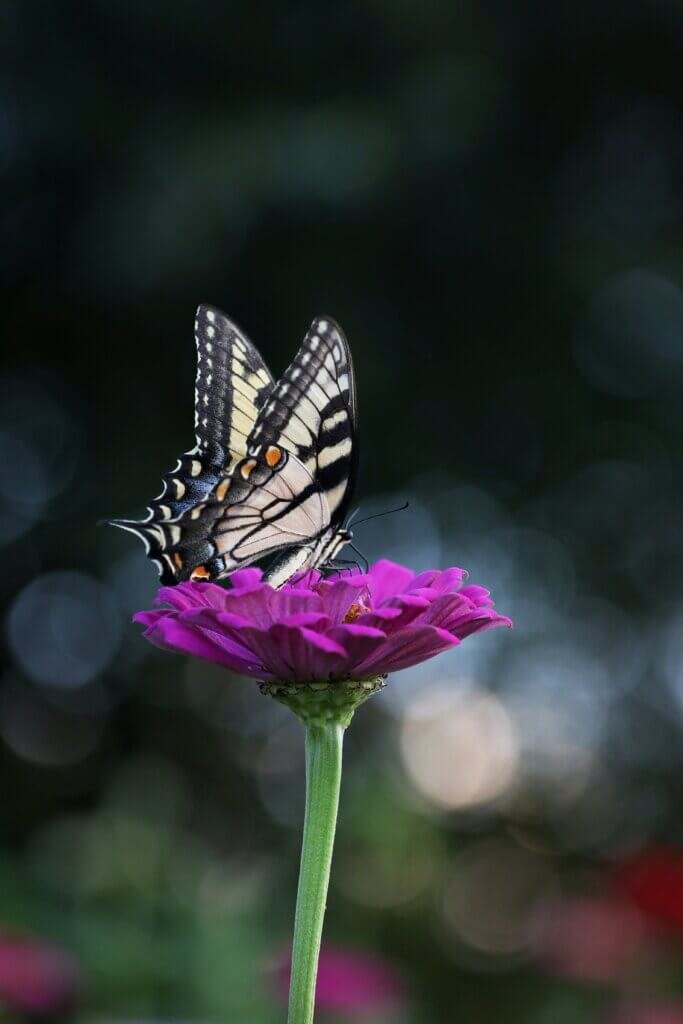
7. Creating a Butterfly Garden
Butterflies are not only beautiful and fascinating creatures, but they are also important pollinators. Creating a butterfly garden can attract these delicate insects and provide them with the resources they need to thrive. Here are some tips for creating a butterfly-friendly garden:
7.1 Planting Host Plants for Butterflies
Butterflies lay their eggs on specific host plants, which caterpillars feed on. To attract butterflies to your garden, include host plants that are suitable for the species native to your region. For example, milkweed is a host plant for monarch butterflies, while parsley and dill attract swallowtails. Research the specific host plants for the butterflies you want to attract and plant them in your garden.
7.2 Including Nectar Plants for Feeding
Butterflies rely on nectar as their primary food source. Include a variety of nectar-rich flowers in your butterfly garden to provide a continuous source of food for adult butterflies. Butterflies are particularly attracted to flowers with flat surfaces or clusters of small flowers that they can easily land on. Plant flowers like coneflowers, black-eyed Susans, zinnias, and asters to attract and feed butterflies.
7.3 Providing Sunning and Resting Spots
Butterflies need sunny spots to warm up their bodies before they can fly and search for food. Create sunning spots in your garden by placing flat rocks or stones in sunny locations. Butterflies will perch on these rocks and soak up the warmth from the sun. Additionally, provide resting spots for butterflies, such as tall grasses or low shrubs, where they can rest and take shelter from strong winds or predators.
7.4 Creating a Mud Puddle
Some butterfly species, particularly males, require minerals and salts from the soil to supplement their diet. Create a mud puddle in your garden by digging a shallow depression and filling it with damp soil. Butterflies will gather around the mud puddle to extract essential nutrients and minerals. Make sure to keep the puddle moist and replenish the soil as needed.
8. Attracting Hummingbirds to Your Garden
Hummingbirds are fascinating creatures known for their vibrant colors and unique flying abilities. Attracting these tiny birds to your garden can be a rewarding experience. Here are some tips for creating a hummingbird-friendly garden:
8.1 Planting Hummingbird-Friendly Flowers
Hummingbirds are attracted to brightly colored flowers with tubular shapes that allow them to access the nectar with their long beaks. Incorporate a variety of flowers that bloom at different times to provide a continuous source of nectar. Some popular hummingbird-friendly flowers include cardinal flower, bee balm, salvia, columbine, and trumpet vine. Choose flowers with colors like red, orange, and pink, as these are most attractive to hummingbirds.
8.2 Incorporating Hummingbird Feeders
In addition to planting flowers, you can attract hummingbirds by hanging hummingbird feeders in your garden. Fill the feeders with a homemade nectar solution made of four parts water to one part white granulated sugar. Avoid using honey or artificial sweeteners in the nectar, as they can be harmful to hummingbirds. Hang the feeders in a visible and easily accessible location, and clean them regularly to prevent the growth of mold or bacteria.
8.3 Maintaining a Clean Feeder
Hummingbird feeders should be cleaned regularly to ensure the health and safety of the hummingbirds. Clean the feeder at least once a week or more frequently in hot weather. Use hot water and a bottle brush to remove any mold or debris from the feeder. Rinse it thoroughly and refill it with fresh nectar. Keeping the feeder clean and providing fresh nectar will attract more hummingbirds to your garden.
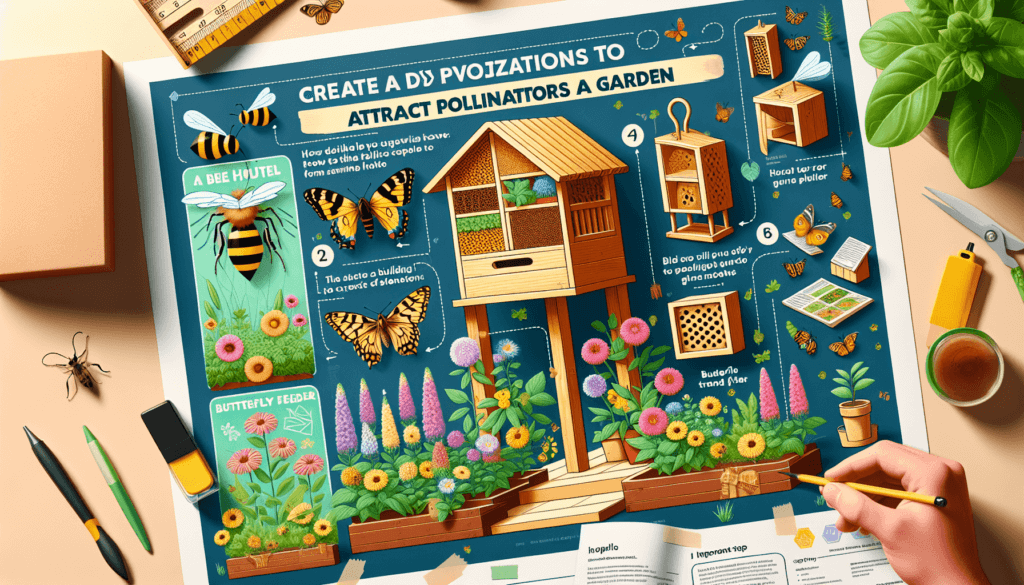
9. Implementing Pollinator-Friendly Lawn Care Practices
Even your lawn can play a role in attracting and supporting pollinators. By implementing pollinator-friendly lawn care practices, you can create a more welcoming environment for bees, butterflies, and other pollinators. Here are some tips:
9.1 Reducing Lawn Size
Consider reducing the size of your lawn to create more space for pollinator-friendly plants. You can convert part of your lawn into flower beds, meadows, or even vegetable gardens. By adding more flowering plants to your landscape, you provide additional food sources for pollinators and create a more diverse and attractive habitat.
9.2 Allowing Clover and Dandelions in Your Lawn
Clover and dandelions are both excellent food sources for bees. Instead of viewing them as weeds, consider allowing them to grow in your lawn. These plants provide nectar for bees and attract other beneficial insects as well. Embracing these “weeds” can significantly contribute to the overall health and diversity of your lawn ecosystem.
9.3 Mowing at the Right Height
When mowing your lawn, set your mower at a higher height to allow flowering plants, such as clover or dandelions, to bloom. Cutting your grass too short can prevent these plants from flowering and reduce their accessibility to pollinators. Leaving your lawn slightly longer also helps shade the soil, reduces water evaporation, and promotes healthier grass growth.
9.4 Using Organic Lawn Care Products
Avoid using chemical pesticides, herbicides, and synthetic fertilizers on your lawn. These products can be harmful to pollinators and may disrupt the delicate ecosystem of your garden. Opt for organic lawn care products or natural alternatives, such as compost and organic mulch, to promote a healthy lawn without harming pollinators.
10. Participating in Citizen Science Projects
Engaging in citizen science projects is a great way to contribute to our understanding of pollinators and help protect their populations. By reporting sightings and participating in monitoring programs, you can make a valuable contribution to pollinator research. Here are some ways you can get involved:
10.1 Joining Pollinator Monitoring Programs
Many organizations and research institutions run pollinator monitoring programs that rely on citizen participation. These programs typically involve observing and documenting the abundance and diversity of pollinators in a specific area. By joining these programs, you can contribute valuable data that helps scientists understand pollinator populations and their health.
10.2 Contributing to Pollinator Research
Citizen scientists can also contribute to pollinator research by participating in specific projects or surveys. These projects may focus on tracking the migration patterns of butterflies, monitoring the nesting habits of bees, or studying the impact of urbanization on pollinator populations. By participating in these research initiatives, you can play an active role in advancing our understanding of pollinators.
10.3 Reporting Sightings of Pollinators
If you observe interesting pollinator behavior or rare species in your garden or local area, consider reporting your observations to relevant organizations or online platforms. Sharing your sightings can help scientists and researchers gain valuable insights into the distribution and behavior of pollinators. There are numerous websites and apps available that allow you to contribute to citizen science projects by reporting sightings.
By incorporating these pollinator-friendly practices into your garden and participating in citizen science projects, you can make a significant impact on the conservation of pollinators. So start creating a pollinator-friendly oasis in your backyard and join the efforts to protect these crucial creatures. With a little effort and the right approach, you can attract a wide variety of pollinators to your garden and help support their vital role in our ecosystems.
